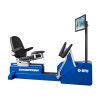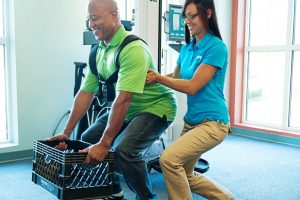
Open vs Closed Kinetic Chain?
Treatment GuidelinesEarly in rehab, one of the primary goals is to address the integrity of the healing tissue. One way to protect the tissue is by working in a CKC position. As the joint becomes more stable, it is more appropriate to add OKC exercises.
Throughout any given day in our therapy setting, we will utilize multiple modalities, exercise devices and treatment techniques. One question that we need to ask ourselves in regards to which exercises are most appropriate is – should I be doing open kinetic chain (OKC) or closed kinetic chain (CKC) exercises with this particular patient? Certainly, there are advantages to both and we will briefly discuss those in this article.
The idea of the kinetic chain was first introduced by a mechanical engineer, named Franz Reuleaux in 1875. Since that time, it has been further understood to be a “combination of several successively arranged joints constituting a complex motor unit.” (1) Typically, clinicians will combine the two concepts as a part of a rehab program in order to address various components of movement.
Why?
First, we will review the OKC concept. Here, you are normally addressing isolated muscle groups or a single joint by ensuring that the hands or feet are not in a fixed position (2). For example, in upper body exercises, the hand will move freely and you are better able to address joint range of motion. In addition, an OKC exercise is also the method used for focusing on a single joint working dynamically, with higher velocity of movement (3). This movement will occur with lower resistance levels or with lower force production from the patient.
A CKC exercise is one where the distal segment is in a fixed or stationary position. As the distal joint is fixed, motion anywhere along the chain will require motion both proximally and distally (4). Among the advantages of CKC exercises are decreased shear forces and increased joint stability. Also, one can generate higher concentric and eccentric forces while stimulating proprioceptors. Many clinicians prefer to use CKC exercises as they are considered more functional and safer. They also allow one to work multiple joints and muscle groups at once.
How?
Early in our rehabilitation process, one of the primary goals is to address the integrity of the healing tissue(s). One way to protect the tissue is by working in a CKC position. As the joint becomes more stable, it is more appropriate to add OKC exercises. If one utilizes the concepts of progressive overload and isolation to integration, you can safely and effectively improve range of motion, improve motor control and build strength.
One highly effective way to perform closed chain motor control learning and strengthening very early in the rehab process is by incorporating a device such as the Eccentron (5). When added to the post ACL rehab process, it allows for better activation and reengagement of the quadriceps and glutes. This in turn leads to the ability to begin more dynamic OKC exercise as appropriate (6).
Therapy is an evolving science and there are many concepts to consider with each client. Each patient is a unique individual with unique needs and there is no ‘recipe book’ for every diagnosis. However, with good judgment, the proper exercises introduced at the proper times will lead to the best possible outcomes.





